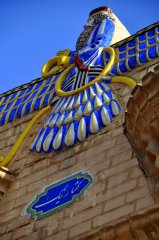HOLIDAY IN IRAN - CULTURE - Glance of old Persia...
The material from which the dreams are - Glory of Persia tour
In Glories of Persia we will visit a collection of beauties of cities such as Shiraz, Kerman, Yazd, Isfahan, Hamedan, Kermanshah, Ahvaz and Teheran which are important historical and cultural cities of Iran.You will make a glorious time for yourself during this unique and unforgettable trip.

Day 1: Arrive in Teheran
Tehran, a modern megalopolis, prides itself in having unique museums with immense and unrivaled collections and artifacts dating from the earliest onset of history to the present era.
Afterwards, we will visit a world of jewels in a priceless Crown Jewels Museum one of which is one of the two greatest diamonds, Darya-e-Noor (the sea of light). Finally, we have a visit to Sa'ad Abad Complex with an immense area of 1,100,000 square meters and 18 magnificent historical palaces (2 of which we will visit). This palace was built by Pahlavi dynasty and it will undoubtedly leave a lasting impression on us.
Day 2: Drive to Hamedan
Hamedan province is situated in the Middle Western Iran. It has long and severe winters from September to May with a great deal of snow; however, in summer its pleasant climate offers visitors a welcome break from the soaring temperatures elsewhere. The province is famous for its raisins (1500 hectares of vineyards) and in the Persian rug trade it ranks second only to Kerman.The next beautiful sightseeing in Hamedan is Esteroo Mord Khay (Ester and Mord Khay) Tomb. Located in the city center, the structure has been constructed of brick and stone. This is the tomb of Ester the Queen of Shoosh (the wife of Xerxes of Iran). Mordecai (Mord Khay) was her uncle. The structure was originally constructed about 11 centuries ago, in order to pay homage to these two personalities. This vicinity is a place for pilgrimage of the Jewish sect, and is also held in respect by the Moslems.
The Isfahan-Hamedan road is one of the most beautiful roads of Iran because it passes through Mount Zagros. On this way you will visit the marvelous attraction of Zagros besides paying a visit to Khansar which is the city of honey in Iran, Golpaygan which is the city of dairy in Iran and Mahalat which is the city of flower in Iran. Overnight in Hamedan
Day 3: Visiting Hamedan, Ali Sadr cave and drive to Kermanshah
The next place is Ganj Nameh Inscription. These inscriptions are relics from the period of 'Darius' and ‘Xerxes' of the Achaemenian era. The said are located 5 km. west of Hamadan at the end of the Abbas Abad Valley, and have been engraved on a mountain.As Avicenna were Muslim Persian physician and philosopher, and wrote almost 450 treatises on a wide range of subjects, of which around 240 have survived. In particular, 150 of his surviving treatises concentrate on philosophy and 40 of them concentrate on medicine, our next step will be Avicenna Tomb. Hegmatane Archeological Palace is located in the city of Hamadan, dating to the 6th century BC. The said structure is from the times of the 'Medes'. 'Kiyakesar Madi' and 'Nabopolasar Baboli' were responsible for building this structure in the year 614 BC. The next fascinating step will be Gonbad-e Alavian (or Masjid-e Alavian) which is a four-sided interesting 12th century mausoleum belonging to the late Seljuk period. On the exterior, it resembles the Gonbad-e Sorkh of Maragheh. (If it will be possible we will see the sight.)Our next site to visit is tomb of Baba Taher, which is located in a park, surrounded by flowers and winding paths. Baba Taher is known as one of the most revered and respectable early poets in Iranian literature. He was known by the name of Baba Taher-e Oryan (The Naked), which suggests that he may have been a wandering dervish. His poetry has touched many souls.The last stop will be Ali Sadr Cave which is the world's largest water cave which attracts millions of visitors every year. It is located about 100 kilometers north of Hamedan, western Iran. Since the cave is situated between the large cities Hamadan, Tehran, and Qom it is a popular destination for Iranians. Tours of the cave are available by pedal boats.
The city Kermanshah was once the center of the Median Empire, from which the excavations on the Hegmatana hill are still testifying. Sang-e Shir (the stone lion) is standing in a small park. The mausoleum of the famous medieval doctor Avicenna who was born near the city Buchara now days in Uzbekistan and who died in 1037 in Hamedan is located in the square of “Bu Ali”. The Avicenna University has emerged from his library. Carry on the old caravan route to Bistoon dating back to the Middle Paleolithic. The Achaemenian inscriptions offer details in 1,200 lines about the battles of Darius the Great who fought against the governors trying to dismantle the Empire originally founded by Cyrus. This was the site where the decisive battle took place, leaving the famous Tablets of Darius. Nearby in the village of Sahneh we can visit the tomb of Ostad Khalil Alinejad the best player of Tanboor in the world.In Kermanshah visit the Sassanian rock carvings of Tagh-e-Bostan. These bas-reliefs, cut from the stone cliff, depict royal scenes of battles and hunts reflecting the glorious history of the Sassanid Kings. (if time permits, we will walk)
Day 4: Drive to Ahvaz
We will start our day early in the morning with an interesting drive among the Zagros Mountains to Khorramabad, the capital city of the Luristan province. The path lies through bridges from the Sassanid era in the city of Dezful. In the afternoon we will arrive at Susa, another residential city of the Achaenmenid Kings. A short drive takes us to the Zikkurats excavations (temple tower) from Chogha Zanbil from Elamite period, which is also UNESCO registered under the list of the world heritage. In the early evening, we will arrive to Ahvaz, the capital of Khuzestan.
Day 5: Drive to Shiraz
We will travel through the flat lowland, which borders the Persian Gulf in the South and which has an extremely hot climate during the summer months. During the afternoon we will visit the Sassanid excavation of Bishapour; founded by the Sassanid king, Shapour I. in the 3rd century a.c. Bishapour carries the rock walls of the surrounding reliefs by representing his victories against the roman emperor Gordian III., Valerian and Philips’s Arabs. In the evening we will arrive to Shiraz, the city of the roses and poets.
Day 6: Excursion to Persepolis
Our visit for Today is Persepolis. Founded by Darius I in 518 B.C., Persepolis was the capital of the Achaemenid Empire. It was built on an immense half-artificial, half-natural terrace, where the king of kings created an impressive palace complex inspired by Mesopotamian models. The importance and quality of the monumental ruins make it a unique archaeological site. It seems that Darius planned this impressive complex of palaces not only as the seat of government but also, and primarily, as a show place and a spectacular centre for the receptions and festivals of the Achaemenid kings and their empire such as Nowruz.
The next is Necropolis. Opposite of Rahmat Mountain, ten-minute drive to the north, proudly stands the Necropolis, the magnificent burial place of Achaemenid kings.
The ancient Persian city of Persepolis was one of the capitals of the antique Persia during the Achaemenids and was founded by Darius l. in 520 B.C. in the south of the present-days Iran in the Persia region. The name “Persepolis” comes from the Greek and means “city of the Persians“.
When the former Pasargadae residence was moved 50 km here, a 15 ha large Terrace was laid at the foot of the Kuhe-e Mehr Mountain. Over 14 buildings were achieved on the platform by Darius I and his successors Xerxes, Artaxerxes I. and Artaxerxes II. Other palaces were directly excavated at the foot of the terrace. The palace of city was destroyed by Alexander the Great in 330 B.C. but its reconstructed remained ruins can still be visited. They are UNESCO registered and they can be visited in about 60km northeast of the city Shiraz on the plateau of Marvdasht in the province of Fars. Drive to Shiraz.
Day 7: Shiraz
Shiraz has a reputation as an enlightened city that has been at the centre of Persian culture for more than 2,000 years, and was at one time the country's capital. Shiraz is crowned as the heartland of Persian culture and this city of sophistication will never fail to conjure up images of roses and nightingales, gardens and poetry. Early in the morning, relish in the highlights of Shiraz when it was the capital of Iran during the Zand Dynasty. Be inspired by the glorious Karim Khan palace, the splendid Vakil mosque, Vakil Bazaar and Saray-e-Moshir with its splendid architecture and interesting ethnic souvenir shops, Nasir Almolk mosque. Next, we will stop for a mouth-watering Iranian lunch at one of the traditional restaurants of Shiraz. In the morning, we will visit Ali-Ebn-e-Hamzeh and be prepared to marvel at its beauties. Take a stroll through the Jahan Nama Garden and witness its tall and proud cedars.
This gorgeous city in the province of Fars is home to famous poets such as Hafez and Sa'adi and historical sites from different eras stretching back 6,000 years ago can be found. Hafez is one of great poets who impressed everyone with his mastery. His poems give us a special feeling and the peace in his tomb is really outstanding. Sa’adi is a poet, philosopher and mystic who are known as the father of alternative tourism. About seven previous centuries he travelled to different countries and cities. Then he collected all his experiences in verse and Rhyme prose in two books named Boustan and Golestan. These two books give you lots of inspiration and information. We will get a chance to pay homage to tombs of these great poets. At night have welcome dinner in a restaurant with specific atmosphere in the north of Shiraz.
Finally visit the Delgosha Garden and Khajoy-e-Kermani tomb from where the perspective of the mysterious city of Shiraz will perpetuate in our mind.
Day 8: Drive to Kerman
After the breakfast, we will leave Shiraz towards Sarvistan, a city with a mausoleum from the 18th century. Passing Neyriz with a Friday mosque from the Seldjughi era (Mihrab from 1156) we will arrive to Kerman in the evening. Kerman is the capital of the same naming province. Kerman has a long story and was known as Karamani among the Greeks. Ptolemaus and Ammianus Marcellinus mentioned the land by the name Carnabua. Possibly was the city which was founded by the Sassanid king, Ardashir I. in the third century. Kerman is an old city located in the desert, due to this fact Kermani people are experts of constructing gardens and Qanats (aqueduct).
Day 9: Kerman and excursion to Rayen and Mahan
. Mahan is well-known for the tomb of Shah Ne'emat Ollah-e-Vali, the great Sufi leader, as well as Shazdeh Garden (Prince Garden). Shazdeh Garden (Prince’s Garden) is a historical Persian garden located near (6km away from) Mahan which is one of the samples of building garden in the heart of desert. The garden is 5.5 hectares with a rectangular shape and a wall around it. It consists of an entrance structure and gate at the lower end and a two-floor residential structure at the upper end. The distance between these two is ornamented with water fountains that are engined by the natural incline of the land. The garden is a fine example of Persian gardens that take advantage of suitable natural climate. En route, pay a visit to Rayen castle which is a good replica for Bam citadel. The Rayen castle is a beautiful and wonderful castle which will surely attract you.
Day 10: Drive to Yazd
Our journey takes us from Kerman through the southern sandstone desert along the Zagros Mountains to Yazd. We will have a stop before Yazd in the Zeyn-o-Din caravanserai from safavid era. We will arrive to Yazd in the afternoon, which is an important center for the Zaroastrian religion until today. Center of worship is the fire sanctuary, which was built in its present form in 1900.
Day 11: Drive to Isfahan via Nain
Yazd, the oldest adobe city in the world which is surrounded by the 4000m summit of Shirkooh and two majestic deserts of Iran, Dasht-e-Kavir and Kavir-e-Loot. This ancient city is furnished with mosques of stunning beauty. The co-existence of the splendid fire temples and the holy sites of different religions astonish every visitor. In the center of the city, near the bazar, is the Mosalla Atiq, which is used these days as Medrese. After the lunchtime in Yazd, we will commence our drive to Nain. Nain is known as the city of cisterns and possesses around 80 cisterns. We will get a chance to visit one of the oldest and most important mosques of Persian Islamic architecture. Nain and the old town are frequented in the past and wide. The Friday mosque of the city is one of the oldest sacral built in Iran. We will arrive in Isfahan early in the evening.
Day 12: Isfahan
Isfahan the legendary city which never fails to enchant its visitors is the pearl of traditional Islamic archeology. This city is revived by the works of contemporary artists. Isfahan prides itself in having fascinating historical garden palaces. Legend has it that the city was founded at the time of Tahmoures or Keykavous and because of its glories has been entitled “Half the World”. Our full day tour includes the famed Imam Square (Naqsh-e-Jahan), a huge square second in the world to Beijing's Tiananmen Square. Tour the architectural marvels of Sheikh Lotfollah and Imam Mosques, Aliqapu Palace and Chehel Sutoon, and also visit one of the most famous bazaars in Iran, where we can purchase the arts & crafts for which Isfahan is so well renowned.
Day 13: Isfahan
Isfahan’s Jame' mosque holds in itself the passage of several centuries of historical Islamic evolution. This mosque is a gallery of Islamic architecture in which the progress of the architecture from the outset of Islam till recent times is evident. Then we will visit Vank Church which is one of the most beautiful Armenian churches in the world and will undoubtedly capture the attention of every Christian. Our day will conclude with a visit to some historical bridges like Pol-e Khajoo and Pol-e Shahestan. . Evening is free at leisure.
Day 14: Transfer to airport and depart Iran
Early in the morning we will be transfer to airport and fly back to Vienna via Istanbul.

Service included:
- Invitation letter for Iran visa
- 11 Nights stay in 4Star Hotels in Doublerooms and 2 Nights in a 3* Hotel in Doubleroom in Kerman
- 14 x breakfast
- All the entrance fees
- All transfers and transportations (Airport and Inland) with car for the whole trip (PKW 5 persons) based on the group size
List of hotels:
- Evin Parsian 4* Hotel in Teheran
- Azadi 4* Hotel in Hamedan
- Jamshid 4* Hotel in Kermanshah
- Pars 4* Hotel in Ahvaz
- Setaregan 4* Hotel in Shiraz
- Guashir 3* Hotel in Kerman
- Mehr 4* Hotel in Yazd
- Safir 4* Hotel in Isfahan
Service not included:
- International flights
- Tip for guide and driver
- German speaking tour leader for 14 days
- Travel insurance
- Visa and visa costs
- Lunch , dinner
CIP services in IKA Airport exclusive for Alvantour clients:
- VIP Visa issuing service on arrival (excl. visa fee)
- VIP passport check,
- VIP security check,
- VIP transport to /from the aircraft,
- VIP waiting hall with warm buffet and drinks
- Package price 65,- EUR
Tourempfehlung - Der Glanz des alten Persien
20141021glorie-1.jpg
20141021glorie-3.jpg
20141021glorie-2.jpg
20141021glorie-4.jpg
20141021glorie-5.jpg
20141021glorie-6.jpg
20141021glorie-7.jpg
20141021glorie-8.jpg


 English
English  Deutsch
Deutsch  简体中文(中国)
简体中文(中国)  French
French  Persian
Persian 







